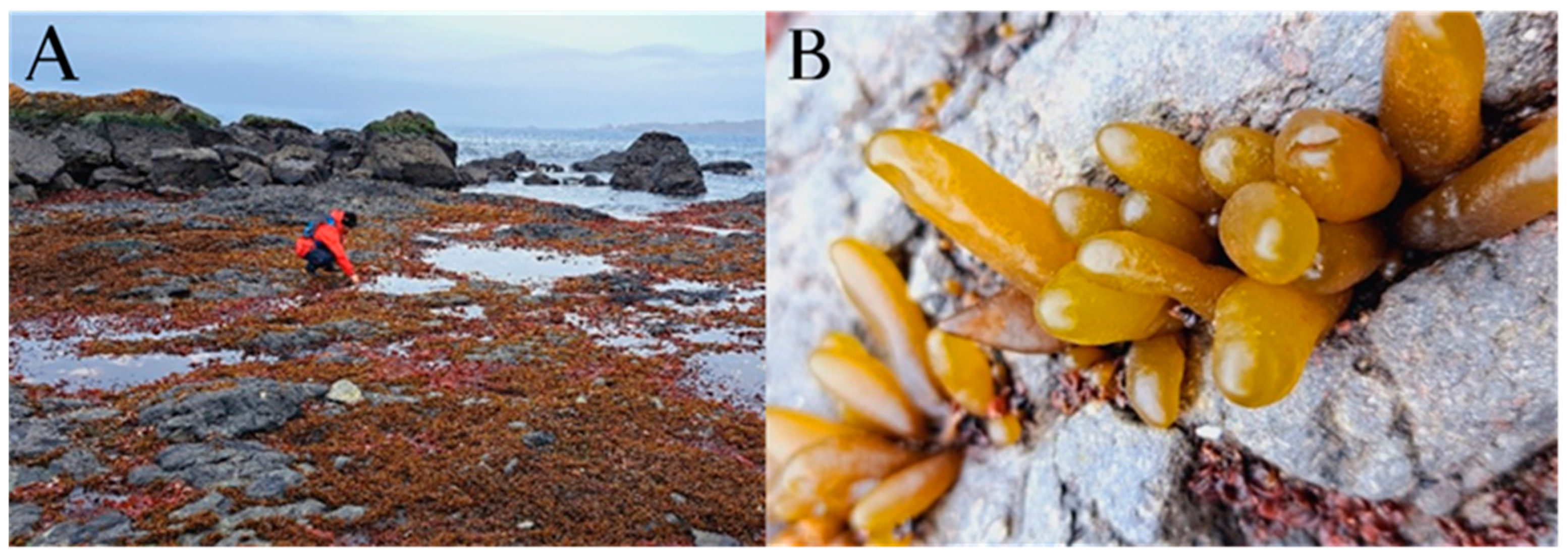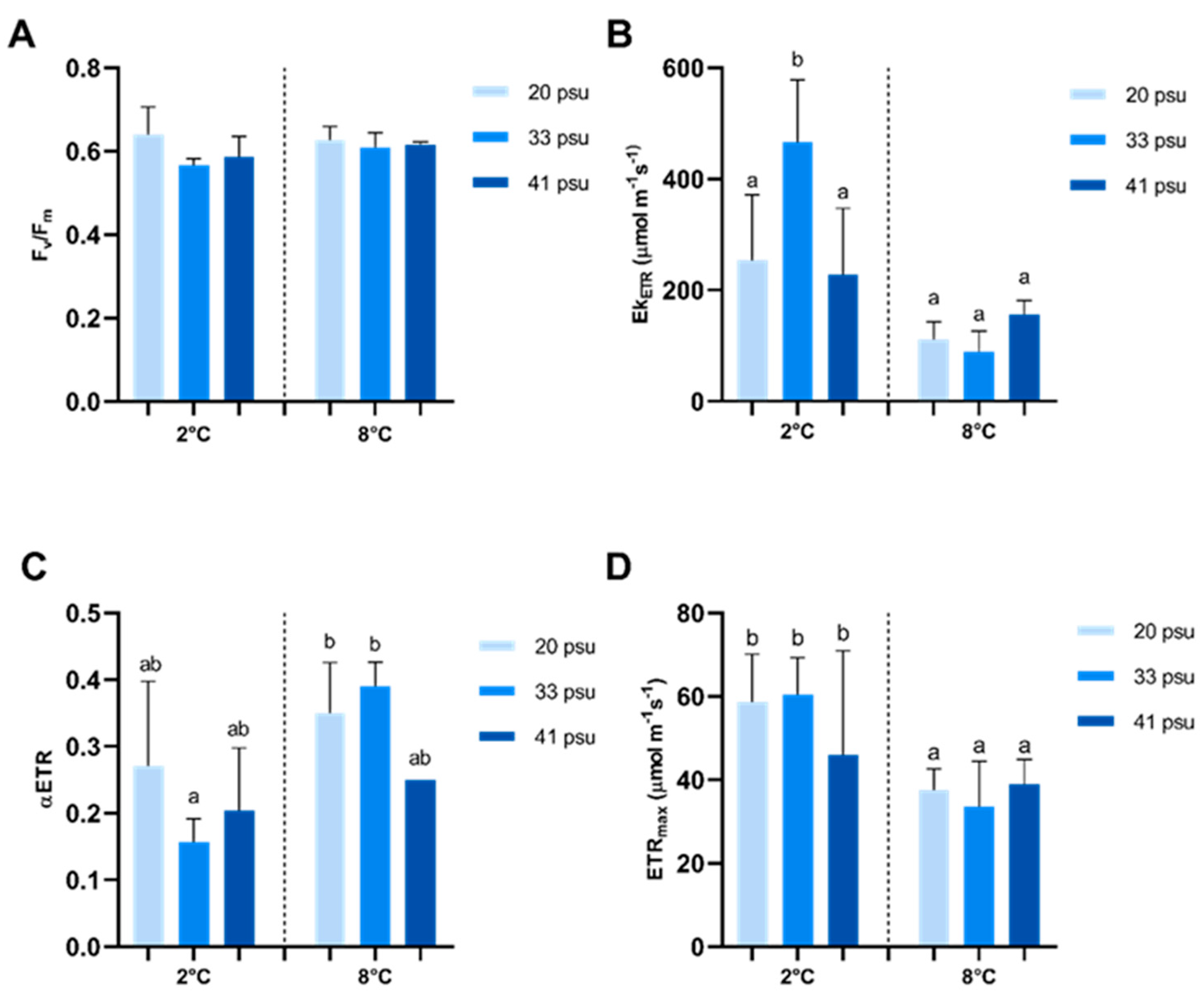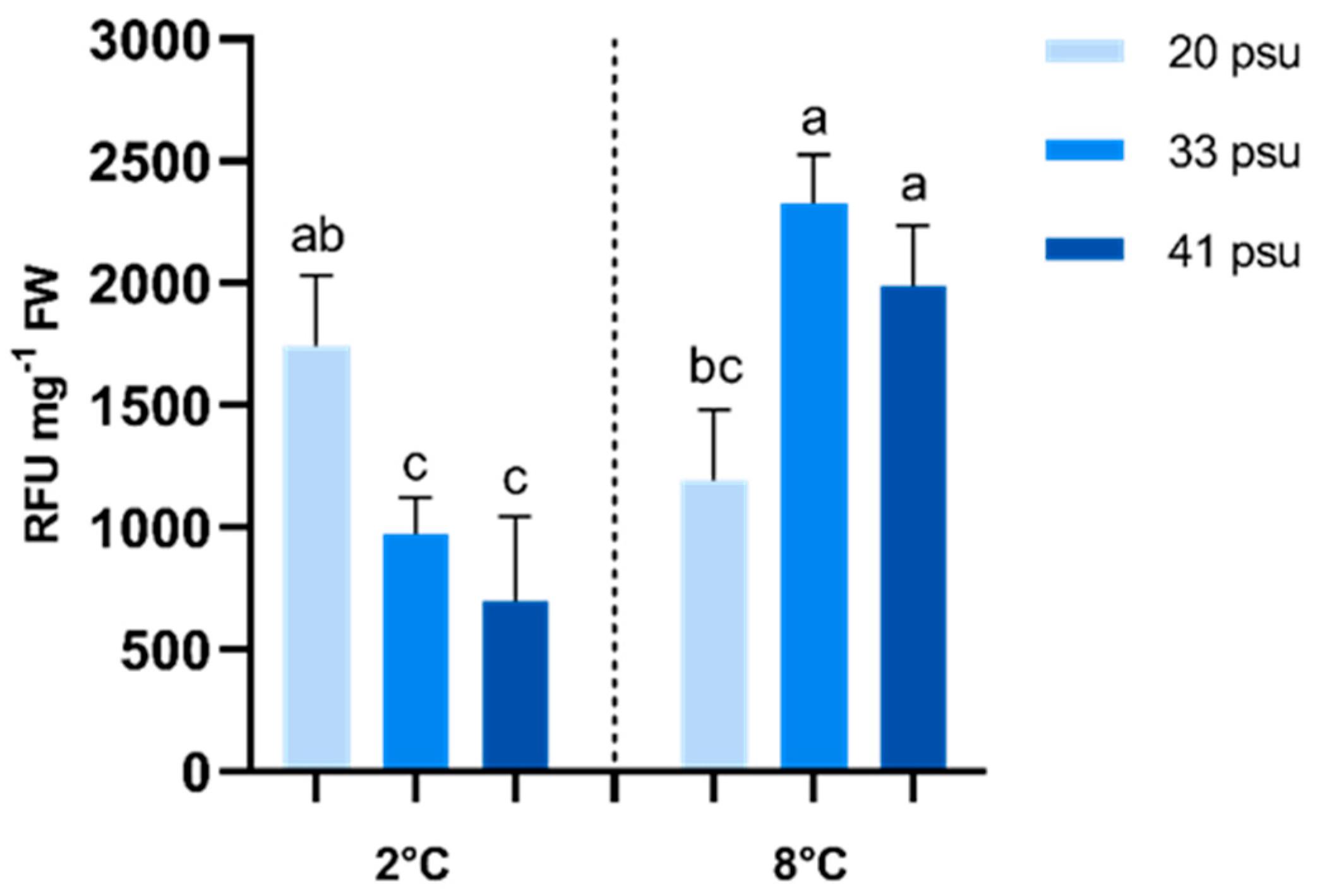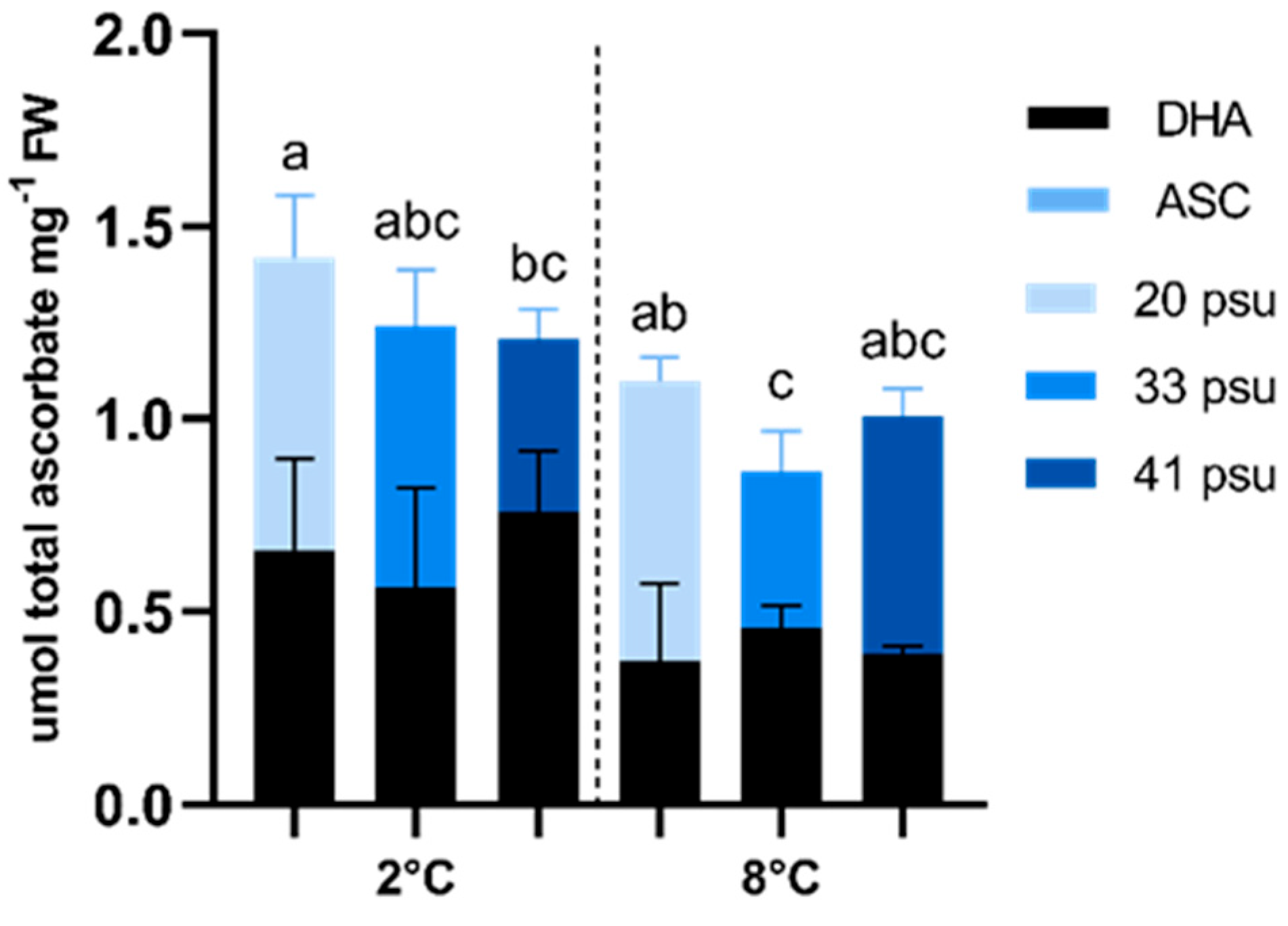Climate Change-Related Salinity Fluctuations and Warming Induce Physiological Stress and Cellular Alterations in an Antarctic Intertidal Brown Alga
Abstract
1. Introduction
2. Materials and Methods
2.1. Samples Collection and Culture Conditions
2.2. Photosynthesis and Energy Dissipation as In Vivo Chlorophyll a Fluorescence
2.3. Total ROS Content
2.4. Quantification of Lipid Oxidative Damage
2.5. Quantification of Protein Oxidative Damage
2.6. Quantification of Free Amino Acids and Proline
2.7. Quantification of Ascorbate and Dehydroascorbate
2.8. Statistical Analysis
3. Results
3.1. Physiological Responses of A. utricularis to Salinity Fluctuations and Elevated Temperatures
3.2. Oxidative Stress and Damage in A. utricularis Under Salinity Fluctuations and Elevated Temperatures
3.3. Osmotic and Antioxidant Responses in A. utricularis Under Salinity Fluctuations and High Temperatures
4. Discussion
4.1. Photosynthetic Performance in A. utricularis Under Salinity Fluctuations and Elevated Temperatures
4.2. Oxidative Stress and Damage in A. utricularis Under Salinity Fluctuations and Elevated Temperatures
4.3. Osmotic and Antioxidant Responses in A. utricularis Under Salinity Fluctuations and High Temperatures
5. Conclusions
Author Contributions
Funding
Data Availability Statement
Acknowledgments
Conflicts of Interest
References
- Convey, P.; Peck, L.S. Antarctic environmental change and biological responses. Sci. Adv. 2019, 5, eaaz0888. [Google Scholar] [CrossRef] [PubMed]
- IPCC. Climate Change 2023: Synthesis Report. In Contribution of Working Groups I, II and III to the Sixth Assessment Report of the Intergovernmental Panel on Climate Change; Core Writing Team, Lee, H., Romero, J., Eds.; IPCC: Geneva, Switzerland, 2023; pp. 35–115. [Google Scholar] [CrossRef]
- Siegert, M.; Atkinson, A.; Banwell, A.; Brandon, M.; Convey, P.; Davies, B.; Downie, R.; Edwards, T.; Hubbard, B.; Marshall, G.; et al. The Antarctic Peninsula under a 1.5 °C global warming scenario. Front. Environ. Sci. 2019, 7, 102. [Google Scholar] [CrossRef]
- Hill, E.A.; Gudmundsson, G.H.; Chandler, D.M. Ocean warming as a trigger for irreversible retreat of the Antarctic ice sheet. Nat. Clim. Chang 2024, 14, 1165–1171. [Google Scholar] [CrossRef]
- Röthig, T.; Trevathan-Tackett, S.M.; Voolstra, C.R.; Ross, C.; Chaffron, S.; Durack, P.J.; Warmuth, L.M.; Sweet, M. Human-induced salinity changes impact marine organisms and ecosystems. Glob. Change Biol. 2023, 29, 4731–4749. [Google Scholar] [CrossRef]
- Umbert, M.; De Andrés, E.; Sánchez, M.; Gabarró, C.; Hoareau, N.; González-Gambau, V.; García-Espriu, A.; Olmedo, E.; Raj, R.P.; Xie, J.; et al. Contribution of satellite sea surface salinity to the estimation of liquid freshwater content in the Beaufort Sea. Ocean Sci. 2024, 20, 279–291. [Google Scholar] [CrossRef]
- Miller, C.A.; Gazeau, F.; Lebrun, A.; Gattuso, J.P.; Alliouane, S.; Urrutti, P.; Schlegel, R.W.; Comeau, S. Productivity of mixed kelp communities in an Arctic fjord exhibit tolerance to a future climate. Sci. Total Environ. 2024, 930, 172571. [Google Scholar] [CrossRef] [PubMed]
- Watt, C.A.; Scrosati, R.A. Seaweeds as ecosystem engineers. Bull. Ecol. Soc. Am. 2014, 95, 250–251. [Google Scholar] [CrossRef]
- Gómez, I.; Huovinen, P. Antarctic Seaweeds: Diversity, Adaptation and Ecosystem Services, Adaptation and Ecosystem Services; Springer International Publishing: Berlin/Heidelberg, Germany, 2020. [Google Scholar] [CrossRef]
- Kaviraj, A.; Unlu, E.; Gupta, A.; El Nemr, A. Biomarkers of environmental pollutants. BioMed Res. Int. 2014, 2014, 806598. [Google Scholar] [CrossRef]
- Kaur, M.; Saini, K.C.; Ojah, H.; Sahoo, R.; Gupta, K.; Kumar, A.; Bast, F. Abiotic stress in algae: Response, signaling and transgenic approaches. J. Appl. Phycol. 2022, 34, 1843–1869. [Google Scholar] [CrossRef]
- Moenne, A.; González, A.; Sáez, C.A. Mechanisms of metal tolerance in marine macroalgae, with emphasis on copper tolerance in Chlorophyta and Rhodophyta. Aquat. Toxicol. 2016, 176, 30–37. [Google Scholar] [CrossRef]
- Ren, C.G.; Liu, Z.Y.; Wang, X.L.; Qin, S. The seaweed holobiont: From microecology to biotechnological applications. Microb. Biotechnol. 2022, 15, 738–754. [Google Scholar] [CrossRef]
- Liang, W.; Ma, X.; Wan, P.; Liu, L. Plant salt-tolerance mechanism: A review. Biochem. Biophys. Res. Commun. 2018, 495, 286–291. [Google Scholar] [CrossRef]
- Celis-Plá, P.S.M.; Moenne, F.; Rodríguez-Rojas, F.; Pardo, D.; Lavergne, C.; Moenne, A.; Brown, M.T.; Huovinen, P.; Gómez, I.; Navarro, N.; et al. Antarctic intertidal macroalgae under predicted increased temperatures mediated by global climate change: Would they cope? Sci. Total Environ. 2020, 740, 140379. [Google Scholar] [CrossRef] [PubMed]
- Marambio, J.; Rosenfeld, S.; Bischof, K. Hyposalinity affects diurnal photoacclimation patterns in the rhodophyte Palmaria palmata under mimicked Arctic summer conditions. J. Photochem. Photobiol. 2022, 11, 100124. [Google Scholar] [CrossRef]
- Sáez, C.A.; Troncoso, M.; Navarrete, C.; Rodríguez-Rojas, F.; Navarro, N.; Trabal, A.; Lavergne, C.; Pardo, D.; Brown, M.T.; Gómez, I.; et al. Photoprotective responses of three intertidal Antarctic macroalgae to short-term temperature stress. Front. Mar. Sci. 2023, 10, 1223853. [Google Scholar] [CrossRef]
- Piccini, C.; Bertoglio, F.; Sommaruga, R.; Martínez de La Escalera, G.; Pérez, L.; Bugoni, L.; Bergamino, L.; Evangelista, H.; García-Rodríguez, F. Prokaryotic richness and diversity increased during Holocene glacier retreat and onset of an Antarctic Lake. Commun. Earth Environ. 2024, 5, 94. [Google Scholar] [CrossRef]
- Parodi, C.; Cerpa, L.; Zhu, Z.; Zhang, J.; Muniz, P.; Venturini, N. Tracking suspended particulate organic matter biochemistry from glacial meltwater runoff to coastal waters of an Antarctic fjord. Mar. Chem. 2024, 267, 104455. [Google Scholar] [CrossRef]
- Kim, B.; Lee, Y.; Hwang, J.Y.; Kim, Y.K.; Kim, T.; Kim, I.N.; Kang, S.; Kim, J.H.; Rhee, J.S. Physiological and molecular responses of Antarctic harpacticoid copepod Tigriopus kingsejogensis to salinity fluctuations—A multiregional study. Environ. Res. 2022, 204, 112075. [Google Scholar] [CrossRef]
- Schreiber, U.; Bilger, W.; Neubauer, C. Chlorophyll Fluorescence As a Nonintrusive Indicator for Rapid Assessment of In Vivo Photosynthesis; Springer Berlin Heidelberg: Berlin/Heidelberg, Germany, 1995; pp. 49–70. [Google Scholar] [CrossRef]
- Celis-Plá, P.S.M.; Bouzon, Z.L.; Hall-Spencer, J.M.; Schmidt, E.C.; Korbee, N.; Figueroa, F.L. Seasonal biochemical and photophysiological responses in the intertidal macroalga Cystoseira tamariscifolia (Ochrophyta). Mar. Environ. Res. 2016, 115, 89–97. [Google Scholar] [CrossRef]
- Figueroa, F.L.; Conde-Alvarez, R.; Gómez, I. Relations between electron transport rates determined by pulse amplitude modulated chlorophyll fluorescence and oxygen evolution in macroalgae under different light conditions. Photosynth. Res. 2003, 75, 259–275. [Google Scholar] [CrossRef]
- Figueroa, F.L.; Domínguez-González, B.; Korbee, N. Vulnerability and acclimation to increased UVB radiation in three intertidal macroalgae of different morpho-functional groups. Mar. Environ. Res. 2014, 97, 30–38. [Google Scholar] [CrossRef]
- Eilers, P.H.C.; Peeters, J.C.H. A model for the relationship between light. intensity and the rate of photosynthesis in phytoplankton. Ecol. Model. 1988, 42, 199–215. [Google Scholar] [CrossRef]
- Pérez-Hernández, G.; Morales, D.; Pereira-Rojas, J.; Díaz, M.J.; Blanco-Murillo, F.; Sola, I.; Rámila, C.; González, C.; González, K.; Sánchez-Lizaso, J.L.; et al. The halotolerant white sea anemone Anthothoe chilensis, highly abundant in brine discharges zones, as a promising biomonitoring species for evaluating the impacts of desalination plants. Desalination 2024, 581, 117612. [Google Scholar] [CrossRef]
- Underwood, A.J. Experiments in Ecology: Their Logical Design and Interpretation Using Analysis of Variance; Cambridge University Press: Cambridge, UK, 1996. [Google Scholar] [CrossRef]
- Rothäusler, E.; Rugiu, L.; Jormalainen, V. Forecast climate change conditions sustain growth and physiology but hamper reproduction in range-margin populations of a foundation rockweed species. Mar. Environ. Res. 2018, 141, 205–213. [Google Scholar] [CrossRef]
- Gordillo, F.J.; Carmona, R.; Jiménez, C. A Warmer Arctic Compromises Winter Survival of Habitat-Forming Seaweeds. Front. Mar. Sci. 2022, 8, 750209. [Google Scholar] [CrossRef]
- Luo, M.B.; Liu, F. Salinity-induced oxidative stress and regulation of antioxidant defense system in the marine macroalga Ulva prolifera. J. Exp. Mar. Biol. Ecol. 2011, 409, 223–228. [Google Scholar] [CrossRef]
- Rodríguez-Rojas, F.; López-Marras, A.; Celis-Plá, P.S.; Muñoz, P.; García-Bartolomei, E.; Valenzuela, F.; Sáez, C.A. Ecophysiological and cellular stress responses in the cosmopolitan brown macroalga Ectocarpus spp. as biomonitoring tools for assessing desalination brine impacts. Desalination 2020, 489, 114527. [Google Scholar] [CrossRef]
- Diehl, N.; Karsten, U.; Bischof, K. Impacts of combined temperature and salinity stress on the endemic Arctic brown seaweed Laminaria solidungula J. Agardh. Polar Biol. 2020, 43, 647–656. [Google Scholar] [CrossRef]
- Barera, S.; Forlani, G. The role of proline in the adaptation of eukaryotic microalgae to environmental stress: An underestimated tool for the optimization of algal growth. J. Appl. Phycol. 2023, 35, 1635–1648. [Google Scholar] [CrossRef]
- Xing, H.; Li, Q.; Zhao, Y.; Gao, H.; Li, L.; Zhang, Y.; Yu, X. Exogenous proline boosts the co-accumulation of astaxanthin and biomass in stress-induced Haematococcus pluvialis. Bioresour. Technol. 2023, 369, 128488. [Google Scholar] [CrossRef] [PubMed]
- Hayat, S.; Hayat, Q.; Alyemeni, M.N.; Wani, A.S.; Pichtel, J.; Ahmad, A. Role of proline under changing environments: A review. Plant Signal. Behav. 2012, 7, 1456–1466. [Google Scholar] [CrossRef]
- Foyer, C.H.; Noctor, G. Ascorbate and glutathione: The heart of the redox hub. Plant Physiol. 2011, 155, 2–18. [Google Scholar] [CrossRef]
- Dummermuth, A. Antioxidative properties of marine macroalgae from the Arctic Antioxidative Eigenschaften mariner Makroalgen der Arktis. Ber. Polarforsch. Meeresforsch. Rep. Polar Mar. Res. 2003, 458, 9–11. [Google Scholar]
- Maharana, D.; Das, P.B.; Verlecar, X.N.; Pise, N.M.; Gauns, M. Oxidative stress tolerance in intertidal red seaweed Hypnea musciformis (Wulfen) in relation to environmental components. Environ. Sci. Pollut. Res. 2015, 22, 18741–18749. [Google Scholar] [CrossRef] [PubMed]
- Filbee-Dexter, K.; Wernberg, T.; Grace, S.P.; Thormar, J.; Fredriksen, S.; Narvaez, C.N.; Feehan, C.J.; Norderhaug, K.M. Marine heatwaves and the collapse of marginal North Atlantic kelp forests. Sci. Rep. 2020, 10, 13388. [Google Scholar] [CrossRef] [PubMed]
- Lebrun, A.; Comeau, S.; Gazeau, F.; Gattuso, J.P. Impact of climate change on Arctic macroalgal communities. Glob. Planet. Change 2022, 219, 103980. [Google Scholar] [CrossRef]
- Niedzwiedz, S.; Bischof, K. Glacial retreat and rising temperatures are limiting the expansion of temperate kelp species in the future Arctic. Limnol. Oceanogr. 2023, 68, 816–830. [Google Scholar] [CrossRef]







Disclaimer/Publisher’s Note: The statements, opinions and data contained in all publications are solely those of the individual author(s) and contributor(s) and not of MDPI and/or the editor(s). MDPI and/or the editor(s) disclaim responsibility for any injury to people or property resulting from any ideas, methods, instructions or products referred to in the content. |
© 2025 by the authors. Licensee MDPI, Basel, Switzerland. This article is an open access article distributed under the terms and conditions of the Creative Commons Attribution (CC BY) license (https://creativecommons.org/licenses/by/4.0/).
Share and Cite
Morales, F.; Muñoz, P.T.; Undabarrena, A.; Celis-Plá, P.S.M.; Rámila, C.; Aguilar-Muñoz, P.; Molina, V.; Navarro, N.P.; Sáez, C.A.; Lavergne, C.; et al. Climate Change-Related Salinity Fluctuations and Warming Induce Physiological Stress and Cellular Alterations in an Antarctic Intertidal Brown Alga. Environments 2025, 12, 390. https://doi.org/10.3390/environments12100390
Morales F, Muñoz PT, Undabarrena A, Celis-Plá PSM, Rámila C, Aguilar-Muñoz P, Molina V, Navarro NP, Sáez CA, Lavergne C, et al. Climate Change-Related Salinity Fluctuations and Warming Induce Physiological Stress and Cellular Alterations in an Antarctic Intertidal Brown Alga. Environments. 2025; 12(10):390. https://doi.org/10.3390/environments12100390
Chicago/Turabian StyleMorales, Francisca, Pamela T. Muñoz, Agustina Undabarrena, Paula S. M. Celis-Plá, Consuelo Rámila, Polette Aguilar-Muñoz, Verónica Molina, Nelso P. Navarro, Claudio A. Sáez, Céline Lavergne, and et al. 2025. "Climate Change-Related Salinity Fluctuations and Warming Induce Physiological Stress and Cellular Alterations in an Antarctic Intertidal Brown Alga" Environments 12, no. 10: 390. https://doi.org/10.3390/environments12100390
APA StyleMorales, F., Muñoz, P. T., Undabarrena, A., Celis-Plá, P. S. M., Rámila, C., Aguilar-Muñoz, P., Molina, V., Navarro, N. P., Sáez, C. A., Lavergne, C., Cámara, B., Tessini, C., González-Pino, K., Pérez-Hernández, G. B., & Rodríguez-Rojas, F. (2025). Climate Change-Related Salinity Fluctuations and Warming Induce Physiological Stress and Cellular Alterations in an Antarctic Intertidal Brown Alga. Environments, 12(10), 390. https://doi.org/10.3390/environments12100390








